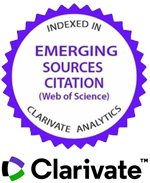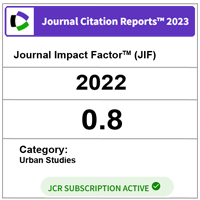The Role of Environment As Third Teacher Towards The Development Of Educational Space For Dyslexic Children
DOI:
https://doi.org/10.11113/ijbes.v6.n2.356Keywords:
learning space design, dyslexia children, environment as third teacher, learning disabilityAbstract
Educational space that responds towards disable learning student needs is vital for a conducive learning environment. This paper explores on learning spaces for disable children namely the dyslexic in reference to the role of environment as the third teacher towards designing an appropriate educational space to fulfil their needs. Past literature on dyslexia in Malaysia much focuses on the pedagogy and teaching methods rather than discusses the issue of providing better learning space design that caters to the need of dyslexic children towards their psychological well-being. To conduct this study, the qualitative method involving case study as research strategy is used to establish the appropriate learning space design attributes for the dyslexic children. Data sources for this study are obtained from direct observation on three selected case studies of prominent learning disability school found in the global context. There are two key factors that contributed in the learning process and development of learning disability student namely the dyslexic children. These are the non-physical elements comprises of visual cues, auditory, tactile and kinaesthetic approaches as well as physical elements encompasses of density and size including spatial layout arrangement. Findings of the study are in the form of established referential guideline design to inform future designers, builders, education providers and related authority on how to build a conducive learning space environment for the dyslexic children. This is vital in improving the quality of public education infrastructure for dyslexic students in the Malaysian context towards their betterment in the future.
References
Adnan, A. H., & Hafiz, I. A. (2001). A Disabling Education: The Case Of Disabled Learners in Malaysia. Disability & Society. 16(5): 655-669.
Ahmad, S. S., Shaari, M. F., Hashim, R., & Kariminia, S. (2015). Conducive Attributes Of Physical Learning Environment At Preschool Level For Slow Learners. Procedia-Social and Behavioral Sciences. 201: 110-120.
Ali, M. M., Mustapha, R., & Jelas, Z. M. (2006). An Empirical Study on Teachers' Perceptions towards Inclusive Education in Malaysia. International Journal Of Special Education. 21(3): 36-44.
Amar, H. (2008). Meeting the Needs Of Children With Disability In Malaysia. Med J Malaysia. 63(1); 1.
Archdaily. (2008). Classroom Design. Retrieved from http://www.archdaily.com/6267/kindergartens-70%C2%BAn-arkitektur/ Date access: 20 January 2019
Brite, J. (2011). Seeyond Architectural Solutions. Retrieved from https://www.architectmagazine.com/technology/products/seeyond-architectural-solutions / Date access: 19 January 2019
Brown, M., & Long, P. (2006). Trends In Learning Space Design. Learning Spaces. 9: 1-9.11.
Démonet, J.-F., Taylor, M. J., & Chaix, Y. (2004). Developmental Dyslexia. The Lancet. 363(9419): 1451-1460.
DSDHA. (2019). Education. Education. 1st. Retrieved from http://www.dsdha.co.uk/projects / Date access: 17 January 2019
Dzalani, H., & Shamsuddin, K. (2014). A Review of Definitions and Identifications of Specific Learning Disabilities in Malaysia and Challenges in Provision of Services. Pertanika Journal of Social Sciences & Humanities. 22(1): 1-18
Frith, U. (2017). Beneath the Surface Of Developmental Dyslexia. In Surface dyslexia. 301-330: Routledge.
Goouch, K. (2008). Understanding Playful Pedagogies, Play Narratives And Play Spaces. Early Years. 28(1): 93-102.
Heschong, L., Wright, R. L., & Okura, S. (2002). Daylighting Impacts On Human Performance In School. Journal of the Illuminating Engineering Society. 31(2): 101-114.
Ismail, A. S., & Abdullah, S. (2018). Learning Space in Public Secondary Schools for Students Psychological Development and Well Being. International Journal of Engineering & Technology. 7(3.25): 365-374.
Jelas, Z. M., & Mohd Ali, M. (2014). Inclusive Education In Malaysia: Policy And Practice. International Journal of Inclusive Education. 18(10): 991-1003.
Lyon, G. R., Shaywitz, S. E., & Shaywitz, B. A. (2003). A Definition Of Dyslexia. Annals Of Dyslexia. 53(1): 1-14.
Malaysia, U. (2014). Children with Disabilities In Malaysia: Mapping The Policies, Programmes, Interventions And Stakeholders. Kuala Lumpur: UNICEF Malaysia.
Muzaliha, M.-N., Nurhamiza, B., Hussein, A., Norabibas, A.-R., Mohd-Hisham-Basrun, J., Sarimah, A., Shatriah, I. (2012). Visual Acuity And Visual Skills In Malaysian Children With Learning Disabilities. Clinical Ophthalmology (Auckland, NZ). 6: 1527.
Nasir, M. N. A., & Efendi, A. N. A. E. (2017). Special education For Children With Disabilities In Malaysia: Progress And Obstacles Muhamad Nadhir Abdul Nasir. Geografia-Malaysian Journal of Society and Space. 12(10): 78-87
Oga, C., & Haron, F. (2012). Life Experiences Of Individuals Living With Dyslexia In Malaysia: A Phenomenological Study. Procedia-Social and Behavioral Sciences. 46: 1129-1133.
Osman, A., Yahaya, W. A. J. W., & Ahmad, A. C. (2015). Educational Multimedia App For Dyslexia Literacy Intervention: A Preliminary Evaluation. Procedia-Social and Behavioral Sciences. 176: 405-411.
Rahman, F. A., Mokhtar, F., Alias, N. A., & Saleh, R. (2012). Multimedia Elements As Instructions For Dyslexic Children. International Journal of Education and Information Technologies. 6(2): 193-200.
Rao, S., Raj, A., Ramanathan, V., Sharma, A., Dhar, M., Thatkar, P. V., & Pal, R. (2017). Prevalence Of Dyslexia Among School Children In Mysore. International Journal of Medical Science and Public Health. 6(1): 159-164.
SEGD. (2019). A Multidisciplinary Community Creating Experiences That Connect People To Place. What is Wayfinding? 1st. Retrieved from https://segd.org/what-wayfinding/ Date access: 18 January 2019
Sinnadurai, S. L. (2018). Phonological Awareness in Young Bilingual Dyslexics in Malaysia. NTNU,
Smith, C. (2017). The Influence of Hierarchy and Layout Geometry in the Design of Learning Spaces. Journal of Learning Spaces. 6(3): 59-67.
Smithsystem. (2019). Designing the Classroom around the Curiculum. Retrieved from https://smithsystem.com/school-setting/classrooms/
Strong-Wilson, T., & Ellis, J. (2007). Children And Place: Reggio Emilia's Environment As Third Teacher. Theory Into Practice. 46(1): 40-47.
Studio, T. (2019). The Perception Of Color In Architecture. Architecture. 1st. Retrieved from https://medium.com/studiotmd/the-perception-of-color-in-architecture-cf360676776c/ Date access: 17 January 2019
Subramaniam, V., Mallan, V. K., & Mat, N. H. C. (2013). Multi-Senses Explication Activities Module For Dyslexic Children In Malaysia. Asian Social Science. 9(7): 241.
Ta, T. L., Wah, L. L., & Leng, K. S. (2011). Employability of People With Disabilities In The Northern States Of Peninsular Malaysia: Employers’ Perspective. Disability, CBR & Inclusive Development. 22(2): 79-94.
Tan, S. H. (2015). Development and Psychometric Properties Of A Scale Assessing The Needs Of Caregivers Of Children With Disabilities. Disability And Health Journal. 8(3): 414-423.
Unicef. (2009). Manual: Child Friendly Schools. New York: UNICEF.
Yacob, S. (2005). Maintenance Management System Through Strategic Planning For Public School In Malaysia. Universiti Teknologi Malaysia
Downloads
Published
How to Cite
Issue
Section
License
Copyright of articles that appear in International Journal of Built Environment and Sustainability belongs exclusively to Penerbit Universiti Teknologi Malaysia (Penerbit UTM Press). This copyright covers the rights to reproduce the article, including reprints, electronic reproductions or any other reproductions of similar nature.
Authors who publish with this journal agree to the following terms:
- This Journal applies Creative Commons Licenses of CC-BY-NC-SA
- Authors retain copyright and grant the journal right of publication with the work simultaneously licensed under a Creative Commons Attribution License that allows others to share the work with an acknowledgement of the work's authorship and publication in this journal.
- Authors are able to enter into separate, additional contractual arrangements for the non-exclusive distribution of the journal's published version of the work (e.g., post it to an institutional repository or publish it in a book), with an acknowledgement of its publication in this journal.
- Authors are permitted and encouraged to post their work online (e.g., in institutional repositories or on their website) prior to and during the submission process, as it can lead to productive exchanges, as well as earlier and greater citation of published work (See The Effect of Open Access).







